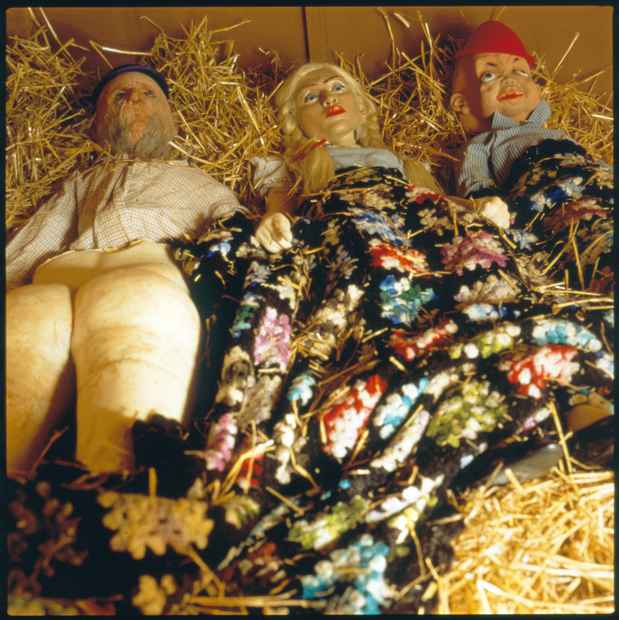Paul McCarthy and Mike Kelley “Heidi, Midlife Crisis Trauma Center and Negative Media-Engram Abreaction Zone”
Deitch Projects (Grand St.)

[Image: © Paul McCarthy and Mike Kelley Foundation for the Arts Courtesy Paul McCarthy, Mike Kelley Foundation for the Arts and Hauser & Wirth]
This event has ended.
Grandfather as I am
Mike protects the sick girl
I work on the Heidi chalet
Neither admits to t*he goat
Heidi as European model as Madonna
Heidi as European fashion
Heidi as a fashion model as Madonna
Heidi as purity – as fashion
Horror movie as model as docudrama
Docudrama as horror movie
Surrogate parts as stand-ins
Stand-ins as stunt props
Disney himself
Modern decorative purity
A lesson in aesthetics
Ultimately a question of taste
Acceptance of the role of beauty as correctness
Insistence on the role of beauty as correctness
Paul McCarthy
Heidi, Midlife Crisis Trauma Center & Negative Media-Engram Abreaction Release Zone (1992), Paul McCarthy and Mike Kelley’s first important collaborative work, combines painting, sculpture, architecture, and performance. Based on Johanna Spyri’s Heidi, a children’s story that deals with the oppositions of city and country, culture and nature, McCarthy and Kelley’s version subverts the familiar tale and turns it into a quasi-horror film. Through McCarthy and Kelley’s piece, the viewer explores the dichotomy between the bucolic and the horrific, and the dialogue between American and European culture. According to McCarthy, “in American horror films, your car runs out of gas in the middle of the woods and you go to the farm house where this crazy inbred family cuts you up. There is this fear of rural life. In Switzerland, you run out of gas and you really do meet Heidi, this sweet young girl or this sweet grandfather who takes care of you. Heidi becomes Americanized in a sort of dysfunctional horror film.”
Heidi… takes place, in McCarthy’s own words, on “a television stage set, a schizophrenic collusion of Alpine decoration and reductive Modernism.” Kelley wrote, “One of the things we were striving for was that the set itself maintain its presence as a sculpture, even when paired with the tape, and that the figures, props, and other items used in the production of the tape, in conjunction with the set, be seen as a whole rather than an accumulation of leftovers.” Presented together, the video and the sculptural installation disorient the viewer, confusing the boundary between what is real and what is not. The cast is found in McCarthy and Kelley themselves, in rubber figures, and scattered body parts. They “perform as different characters, switching identities, becoming Heidi, becoming Peter, becoming Grandfather.” Together, McCarthy and Kelley deconstruct Spyri’s novel, taking on familial relationships, false belief systems, and pushing the boundaries of taste.
This exhibition marks the first time Heidi… is presented in the United States since Paul McCarthy’s 2001 retrospective at the New Museum. The exhibition will open May 2nd and run through June 30th.
Presented in Collaboration with Hauser & Wirth
Media
Schedule
from May 02, 2017 to June 30, 2017